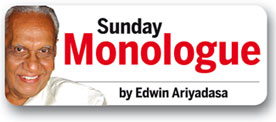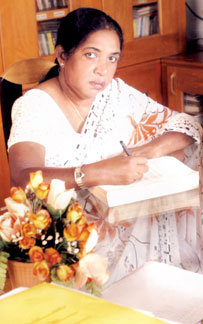Dhara -Profund fiction
 Dhara widens the scope of the Sri Lankan novel. Dhara widens the scope of the Sri Lankan novel.
This has to be asserted straightaway.
To me, it is 3-D fiction, that swaddles you and enfolds you,
absorbing you into its mystifying and eccentric reality.
At surface level, the Sinhala expression "Dhara" simply means
"Stream" - a continuous flow - a non-intermittent movement.
Novelist Kathleene Jayawardene, names her latest work "Dhara",
probably as an echo of the Sinhala rendering of the Joycean "Stream of
Consciousness," which appears in most instances as "Vignana Dhara."
James Joyce, the most reputed exponent of the technique of the "Stream
of Consciousness," resorted to this style, to chronicle the "Interior
Monologue" of a character, tracing the contours of ideas that sweep
along in the mind of an individual. In this approach there is no attempt
to tame the dishevelled and unkempt thought-processes by imposing
grammatical orderliness or syntactic niceties upon them.
It is starkly evident, that Kathleene Jayawardene never made an
effort to follow or to be influenced by the exponents of the "Stream of
Consciousness" mode. This is exactly where Kathleene Jayawardene's
fiction - generating brilliance lies. Her creative preoccupation was to
evolve a fitting vehicle to give adequate vent to the simmering
conflicts that raged within her.
She has come up with a 'construct,' that is an eloquent tribute to
her inventive skills as an unusually gifted creator of fiction.
For the first time in the tradition of Sri Lankan fiction, she brings
in a "gandhabba" (an astral presence) as the protagonist in a novel.
An exegetical discourse on the concept of "gandhabba", is not that
relevant in this context. The novelist adapts this "phenomenon", merely
as a convenient device to dwell upon the essence of her meditations on
the complex web of existence. The choice does not in anyway indicate a
specific religious adherence or a particular spiritual allegiance on the
part of this novelist. But, what is really significant is to observe the
creative efficiency the novelist demonstrates by the deployment of this
strange mechanism.
 |
 |
|
Kathleene Jayawardene
|
|
The central character of the novel, Vasana, is transformed into an
"astral body," enabling her to roam the Earth, at will.
The novelist has to convey a state of experiencing, that has never
been recorded before. She (vasana) discovers that her bodyless spirit,
has begun to float through space, at the speed of wind - or even faster,
at the speed of light. Her refined non-physical "presence" does not
occupy even a little bit of space. The delicate and light ethereal
"being," begins to discover its miraculous potentialities. It can be
present in many places simultaneously.
Immediately, she becomes bereft of her physical body, a scintillating
beam of light appears before her. Breath-taking landscapes, dominated by
mountains and peaks emerge. Shades of light and colour, that scorn the
conventional varieties, flank the tunnel-shaped path, her "spirit"
traverses. The vast space, over which the body-less spirit, exerts its
power, is limitless.
In the midst of all this, the bodyless spirit, suddenly realises,
that they killed her, just a moment ago.
I dwelt somewhat extensively on the initial phase of Kathleene
Jayawardene's latest novel 'Dhara' to communicate an inkling of the
overpowering surprise, that awaits the reader when he takes up this
work. You tend to pose a question at this stage: When she convincingly
establishes, Vasana's transformation into this 'bodyless presence' (gandhabba
state) what can she do or better still, what cannot she do?
The rest of her novel, is her creative response to this question.
What follows in effect, is the most intriguing fictional inventiveness
in the field of the Sinhala novel, in recent years.
What is impressive and highly admirable, is the strong sense of
discipline she imposes on herself. When you discard the conventional
parameters of 'Realism' you cannot rein-in your imagination, that is
throbbing and waiting, raring to go. Like a pet dog, that has just been
untethered, after a spell of restraint, the unleashed imagination too
would be inclined to run around, toppling everything in sight.
But Kathleene Jayawardene's well defined philosophy and her clearly
determined goal for her new work of fiction, curb her wayward fancy. The
eloquent outcome of all this, is a neatly structured work of fiction,
that is unmistakably and unswervingly, on target.
As she states in her introductory note to the novel, one of her
intentions here, is to probe the nature of 'Power' wielded by men and
women. When power escalates, he is elated. At the decline of power, he
is depressed and furious.
The other purpose, she pursues with a missionary zeal, is to expose
man's inhuman attitude towards animals. In her work, she sets aside
space for animals to have their say, without inhibition. She acts as the
intermediary to enable animals to present their grievances against
humans.
In her bodyless state, Vasana finds herself endowed with the gift of
understanding animal language. Her first encounter is with a bat, that
is in a towering rage about man's injustice to animals.
When asked about the latest injustice bats have to suffer, the bat is
quick to rejoin: "The injustice is not to bats, but to fowls."
The writer takes note of the fowls dressed and ready for the table.
The 'Gandhabba' engages in conversation with a non-poisonous, snake, a
pig in the process of being slaughtered slowly, a monkey-among other
animals.
The articulate animal is a new entry into contemporary fiction.
Traditional literature is replete with animals that talk. "Panca Tantra',
an Indian literary classic and the sacred Buddhist work" pansiya panas
Jatakaya' (The Birth Tales) introduce talking animal characters, without
faulting the pace of realistic narration.
In her 'Dhara ' Kathleene Jayawardene, re-introduces the articulate
animal into mainstream Sinhala fiction.
The method is extremely effective, in driving a point home.
Exploiting the technique of the 'Gandhabba' to the hilt, novelist
Kathleene Jayawardene, aims sharp barbs at follies and foibles of men
and women.
Her work looks quite incisively at the ethnic issue, exposing
entrenched prejudices that mar harmony. Throughout the work their is a
process of sleuthing. Her beloved son Damsale, has been assassinated.
She relentlessly pursues the killer, giving the work, enticing
plot-material.
Novelist Kathleene Jayawardene, has evolved a style of writing, in
which verbal maturity is writ large. Her keen feeling for words and
phrases, especially in demotic use, imparts a compelling liveliness to
her agitated prose. Even in contexts, where advocacy is predominant, she
does not betray the slightest traces of didacticism. And, above all, she
is never pontifical.
In her evolution as novelist, she has evolved from mere arithmetic to
calculus.
Where will she go from here? We will wait, until her next effort
appears.
|

